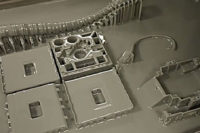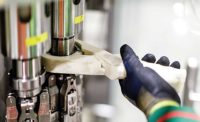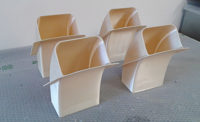How quickly a manufacturer embraces new technology depends on its potential benefits. Three-dimensional printing, for example, enables manufacturers to build 3D parts and products quicker and with more precision than conventional machining.
This capability led medical-device manufacturer Micropulse Inc. to embrace 3D printing nearly 4 years ago. Based in Columbia City, IN, the company wanted to make prototype or sample orthopedic instruments and implants within hours rather than days or weeks.
“Our initial 3D printer used a corn starch material and required postprocessing with additives,” says Brian Emerick, president and CEO of Micropulse Inc. “Parts [from that printer] had a grainy finish, were very brittle and their thread forms did not function well.”
In August 2010, Micropulse replaced the unit with an Objet Alaris30 desktop printer made by Stratasys Inc. Emerick says the printer is used daily by several engineers to make prototypes of various sizes and complexities, including medical devices with tight tolerances.
“When a product is very small, we often increase its size two or three times to see how the different components work together,” says Emerick. “The printed prototype clearly shows component form, fit and interaction.”
Emerick likes that the printer shortens the design cycle. This is very important because Micropulse makes thousands of different products, many in very small quantities (10 to 500). About 20 percent of the products the company makes each month are new.
Besides prototyping, Micropulse uses the Alaris30 to create tooling for production. Specifically, the company creates fixtures and jaws that grip complex-shaped parts. Emerick also says the Alaris machine meets current and projected levels of prototype production.
After reading a CAD part file, the machine builds the prototype by depositing 28-micron layers of photopolymer material onto a build tray and immediately curing each layer with a UV light. Finished prototypes have a resolution of 600-by-600-by-900 dpi, with details and walls as thin as 0.6 millimeter. They are smooth enough to be painted.
Build tray size is 300-by-200-by-150 millimeters, with a net printing area of 294-by-196-by-150 millimeters. The machine holds two cartridges of photopolymer material and support material, enabling Micropulse to perform up to 36 hours of unattended printing. Each cartridge weighs 2.2 pounds.
Emerick says the company uses white and blue material, although it also comes clear, black and gray. He says that certain polymer materials are rubbery or require upgrades to the 3D printer. Support material is gel-like and easily removed with a waterjet or by hand.
The Alaris30 fits on a desk or dedicated stand. Its plugs into a standard 110V outlet and is network-enabled to support multiple designers.
Micropulse opened in 1988 and initially made progressive dies, plastic molds, automated machinery and tooling for several industries. Since 2003, it has focused strictly on the orthopedic industry, providing them with instruments, implants and sterilization cases and trays.
For more information on 3D printers, call 800-801-6491 or visit www.stratasys.com.







